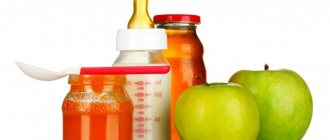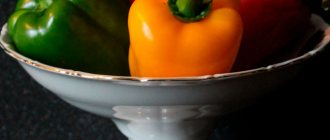How do you know when it’s time for your baby to introduce complementary foods?
Why does your baby need extra feeding?
- Loss of weight occurs;
- Between feedings, the baby is restless, whiny, and demands the breast;
- The baby is constantly hungry, as evidenced by the characteristic crying;
- The child is interested in his spoon;
- The baby does not push the contents of the spoon back. Try letting your baby drink water from a spoon. There was water on the chest - it was too early to introduce complementary foods.
- The child must hold his head well and be able to sit. Lying down, he will not be able to demonstrate to his parents that he does not want to eat;
- The baby begins to teethe;
- The baby watches with interest how his parents eat.
You cannot introduce complementary foods yourself, without consulting a pediatrician.
The benefits of timely introduction of first complementary foods
It is important not to miss the time when introducing new products is really necessary. When formula feeding, feeding often begins early. Complementary feeding from 5 months while breastfeeding also has its positive aspects. How and what are its benefits:
- The first food replenishes the deficiency of essential substances;
- Improving the functioning of the gastrointestinal tract;
- The baby learns to develop chewing skills and trains its jaws to chew food independently.
How to introduce complementary foods at 5 months - features and general rules?
The main rules for introducing complementary foods so as not to harm the health of a five-month-old baby:
- In case of illness, it is necessary to postpone complementary feeding of a five-month-old child until he is completely recovered;
- If vaccination is planned, then you should not introduce a new product a week before and a week after;
- New product is offered in the morning;
- Input begins in minimal volumes (half a teaspoon), gradually increasing the portion;
- One product is introduced, if no allergies are observed in 6-7 days, a new one can be added;
- Usually they start with vegetable purees, gradually adding cereals and fruits.
On a note! If a child is significantly underweight, pediatricians recommend starting with cereals, and then adding vegetables and fruits;
- Mashed potatoes or porridge should be prepared before use; it should not be given to the baby when heated twice;
- Food should be at room temperature.
Complementary feeding and allergies

Improper introduction of complementary foods can lead to an allergic reaction
How to properly introduce complementary foods to a 5-month-old child with allergies?
- Mothers with allergies need to breastfeed their babies longer;
- Allowed first vegetables: zucchini, cauliflower;
- First fruits: green apples, ripe bananas, pears;
- The introduction of a new product to children with allergies begins with a quarter of a teaspoon, monitoring the baby’s reaction;
- Preference should be given to ready-made canned puree;
- Porridges must be gluten-free. Preference is given to buckwheat and rice.
Approximate daily routine for a five month old baby
The daily routine of a five-month-old baby is significantly different from that of a newborn. There is an increase in waking time due to a decrease in sleep duration, the diet changes, and it becomes possible to diversify the menu by introducing complementary foods.
Approximate daily routine for a five month old child by the hour
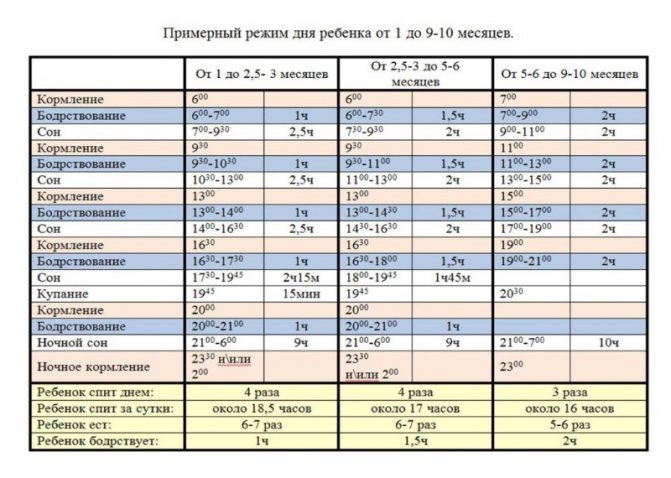
Where to start complementary feeding?
Mothers, having decided to start the first complementary feeding, ask the question: “Where should I start feeding a 5-month-old baby when breastfeeding?” Many people recommend starting with green apple juice. The fruit is quickly absorbed and rarely causes allergies. You can try offering pumpkin juice. It is recommended to start with a few drops diluted with water. In the absence of allergic reactions, the scheme for introducing complementary foods during breastfeeding at 5 months: the next day, give 4 drops, increasing the volume every day. At 6 months, the baby will drink 50 ml of apple or pumpkin juice.
You can offer your baby apple compote. Dry apples are washed and poured with boiling water for several hours.
Many people introduce vegetable purees into their diet first. For infants, vegetables are diluted with mother's milk.
At 5 months, baked green apple pulp is introduced into the baby’s diet. The washed apple should be cut in half, cored and baked. Remove the cooled pulp from the peel and chop. Apples are rich in iron, pectin, and phosphorus. They improve the functioning of the gastrointestinal tract and strengthen the immune system.
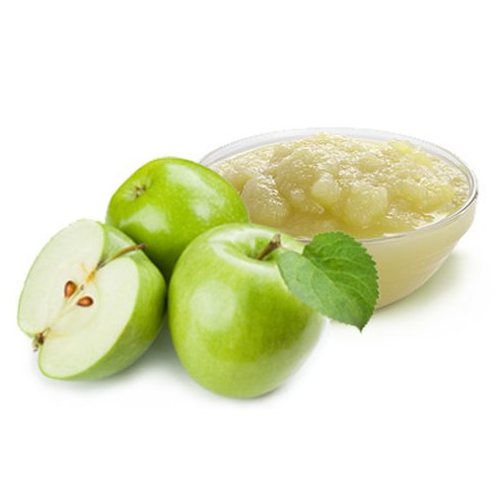
Green apple puree is suitable as the first product for complementary feeding.
What is possible?
What complementary foods can be given to a 5 month old baby? Purees of some vegetables and gluten-free porridges boiled in water are allowed. It’s better to start with zucchini, then add cauliflower the next week, then broccoli. Once the vegetables are fully incorporated, they can be mixed.
It is better to make commercial porridges intended for baby food. They contain a balanced amount of essential substances, they are very finely ground, do not require cooking, and do not contain salt or sugar.
What's not allowed?
In the first months, it is not recommended to give your baby carrots, as they can cause allergic reactions. Your baby should not eat white cabbage, legumes, tomatoes, eggplants, or beets. They are introduced last due to the risk of allergies and gas formation.
Not allowed: cow or goat milk, cottage cheese, meat, fish, eggs. He will get acquainted with these products much later.
Example of a weekly menu
Below is a table with an approximate menu for a baby at 5-6 months. It presents a diet for children who are already familiar with all vegetables and cereals. If necessary, each feeding is accompanied by subsequent supplementary feeding with breast milk or an adapted milk formula.
All porridges should be boiled in water or added to them with mother’s milk or the formula that the baby eats. You can add vegetable oil to the puree.
Menu for the week:
| Day of the week | First breakfast | Second breakfast (porridge) | Lunch (one-ingredient vegetable puree) | Dinner | Second dinner |
| Monday | breast milk or formula | buckwheat | zucchini | breast milk or formula | breast milk or formula |
| Tuesday | rice | cauliflower (we recommend reading: how to prepare cauliflower for baby’s first feeding?) | |||
| Wednesday | corn | broccoli | |||
| Thursday | buckwheat | potato | |||
| Friday | rice | zucchini (we recommend reading: how to properly prepare zucchini for complementary feeding?) | |||
| Saturday | corn | cauliflower | |||
| Resurrection | buckwheat | broccoli |
How should the complementary feeding process take place?
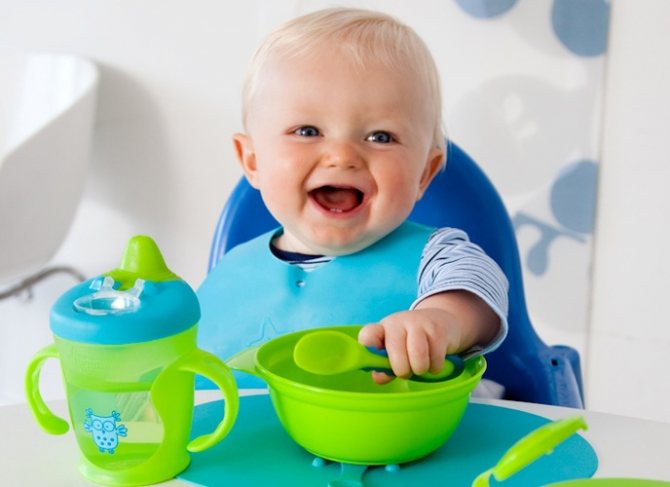
To feed a baby, you should purchase special dishes
Advice for mothers who start feeding their baby at five months:
- Buy special children's dishes: a plate and a silicone/plastic spoon. They can be bought at a pharmacy or in specialized children's departments of supermarkets;
- Be sure to spoon feed your baby. Do not use the bottle, even if the manufacturer indicates that it is intended for liquid food;
- Write down every day what food your child ate and how much. By keeping a diary, it will be much easier to track which product your baby is allergic to. If a rash, redness, intestinal dysfunction, or constipation appears, the new product should be excluded from the diet for a month;
- If you categorically refuse new food, you can add a little breast milk or formula;
- The consistency of the food should be homogeneous and at room temperature;
Should I give my child water to drink?
The baby does not need additional water; WHO advises not to give water before starting complementary feeding. Babies growing up on formula are offered water from birth. When starting complementary feeding, be sure to offer your baby something to drink. After feeding, mother should be offered her milk, water, and compote. If the baby refuses to drink, do not worry, he knows better whether he wants to drink or not. But you definitely need to offer it!
Introduction of a new complementary feeding product
With breastfeeding and artificial feeding, a scheme is often used on how to introduce complementary foods to a 5-month-old baby. We start introducing new foods in the morning. If no redness or rash appears during the day, the portion the next day is doubled, and you can offer the child a whole spoon. By the end of the introduction, a portion of one product will be 100-150 grams. As soon as the new product is fully introduced, it should replace one feeding.
Baby care
The hygienic regime includes washing when changing a diaper, bathing before bed, washing after a morning nap, and cleansing the skin during the day if the child gets dirty while playing or feeding. It is best to bathe your baby before bed, but there are children who become hyperactive after water procedures - it is better for such babies to take a bath in the first half of the day, for example, before napping.
It is recommended to walk with a five-month-old baby 2 times a day. It is best not to put the baby in the stroller immediately after leaving the house, but to hold him in your arms for a while so that the baby can look at the objects, people and animals around him. Even ten-minute “excursions” around your own yard or playground have a positive effect on the development of the visual organs, tactile perception (if the mother allows the child to touch leaves, plants, trees) and the overall intellectual development of the baby. The duration of walks should be at least 2 hours.
The diet of an infant and an artificial one - what is the difference?
The nutrition of a 5-month-old artificial baby is based on infant formula. The gastrointestinal tract adapts much faster to adult food in artificially raised babies than in infants. The amount of puree is determined according to the table. If your child is underweight, your pediatrician may recommend starting with cereal. Usually, gluten-free porridges are prepared for formula-fed children using formula milk.
The diet of a 5-month-old breastfed child is determined by a pediatrician. If the mother has little milk, the baby lacks nutrients; complementary feeding for infants begins at 5 months. If there is underweight, first introduce dairy-free porridge, to which you can add a couple of drops of mother's milk. The volume of complementary foods must correspond to the scheme.
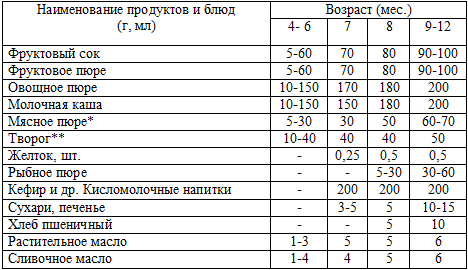
Diet of a five month old baby
The diet of a 5-month-old child should be such that the baby gets used to receiving food at the same time. Complementary feeding chart for a 5 month old breastfed baby:
- After waking up, breast milk.
- Second meal. Vegetable puree or 50 grams of dairy-free, gluten-free porridge. We supplement with breastfeeding.
- Lunch: breast milk
- Dinner: puree (vegetables or fruits), breast milk
- 22.30 Chest
Diet for children using an adapted formula:
- After waking up, milk formula (200 ml)
- 11.30 Porridge prepared with milk mixture
- 15.30 One-component vegetable puree, mixture
- 19.00 Fruit or vegetable puree, mixture
- 22.30 Formula milk

At any age, a diet must be followed
How much complementary food should a 5 month old baby eat?
Many young mothers wonder how much complementary feeding a baby should eat at 5 months?
Children 5 months old who eat formula receive a smaller portion than infants. This is explained by the fact that the mixture is higher in calories than human milk. The baby should eat no more than 900 ml per day. Infants should eat 50 ml of porridge, 50 grams of pureed vegetables and fruits. 5-month-old infants fed formula receive 30 grams of vegetables, fruits and 30 ml of porridge.
Individual approach
Yes, not everyone’s process of establishing nutrition goes smoothly. There are such “gourmets” who refuse everything, even seemingly delicious fruit purees. There are children who react to the most hypoallergenic products with severe rashes.
That is why your diet should be discussed with your pediatrician. Only he will be able to adequately assess the baby’s condition and, based on this information, set the start time for complementary feeding and create the necessary menu JUST FOR YOUR CHILD.
Recipes for dishes that can be given to five-month-old babies
The baby's menu at five months is based on mother's milk or formula. If complementary feeding starts with vegetables, the little one will eat porridge with pleasure. If the acquaintance begins with porridge, he can refuse vegetables, because porridge is much tastier. Many people prefer to make their own puree from organic vegetables. The menu of a 5-month-old baby will be rich in essential microelements. Preparing dishes from vegetables will not take much time, but will bring enormous benefits to the health of the little man.
Porridge
If you are categorically against ready-made baby porridges, try making porridge for your baby yourself. To do this, washed cereals (for example, rice, buckwheat) are ground in a blender or coffee grinder to a powder consistency. Pour a level tablespoon of the mixture into boiling water (100 ml) and cook, stirring continuously, for about 10 minutes over low heat.
Vegetable puree recipes
Broccoli puree
Sort the broccoli, remove leaves and stems, wash thoroughly. Boil until tender in water without adding salt, rub through a sieve. Offer your baby purees at room temperature.

Zucchini puree
Thoroughly peel the young zucchini, wash and remove the seeds. Cut the pulp into small cubes and boil until tender. Cool and blend with a blender until smooth. Give a 5 month old baby puree at room temperature.
Fruit purees
Banana puree
Cut a ripe banana into pieces and grind into a puree. Add a little mixture or milk.
Applesauce
Grind the green apple pulp and add water. Boil the apples until tender, then cool to room temperature and puree in a blender. Add mixture or mother's milk.
What’s better – jars or making your own?
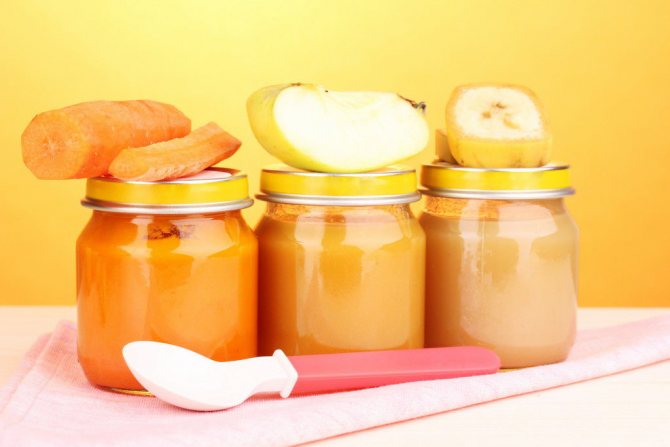
When purchasing ready-made purees, you should choose only trusted manufacturers.
Making puree yourself or buying jars is an individual choice. Pros of canned food:
- Time saving;
- The quality of food is controlled by special services;
- There is a wide range of different manufacturers on sale.
Pros of home cooking:
- Know what products were used;
- You can control the amount of food cooked;
- By using vegetables and fruits grown on your own plot, you can be sure that they are environmentally friendly.
Recipes for baby feeding
Porridge
Rice porridge for babies
There are two ways to prepare porridge for complementary feeding. In the first case, you need to make flour from the cereal. For this you will need a coffee grinder. With its help, you need to grind the cereals, after sorting them out, rinsing them several times and drying them on napkins or paper towels.
Next, the resulting cereal flour is gradually added to boiled water or vegetable broth. In this case, you should continuously stir the future porridge. Then continue to cook it until fully cooked, continuing to stir occasionally to avoid the formation of lumps and burning of the porridge.
The second method boils down to pouring regular cereal with the required amount of water and simply boiling it. After this, it is passed through a sieve or crushed in a blender. Depending on the ratio of water and cereal, the porridge may turn out to be more liquid or, on the contrary, semi-viscous:
| Consistency | Buckwheat | Rice |
| Liquid | 1:4,5 | 1:5,5 |
| Semi-viscous | 1:3,5 | 1:4,5 |
Vegetable puree
It is very important that when preparing baby puree there are no lumps left.
Before cooking vegetables for puree, they should be prepared. To do this, they need to be thoroughly washed and cleaned. Once cleaned, they are washed again under hot water. It is advisable to pour boiling water over them or even leave them in it for 1-2 minutes. Vegetables that have undergone this kind of preparation should be cooked over low heat, covered, in a small amount of water until they are ready.
The next step is to rub the cooked vegetables through a sieve or grind them in a blender, add the broth in which they were cooked and vegetable oil. Everything is mixed and brought to a boil.
Vegetable broth
To prepare vegetable broth you will need:
- vegetables – 50 grams;
- water – 100 ml.
The vegetable that is introduced to the child, for example, broccoli, potatoes or zucchini, must be thoroughly washed, peeled and chopped into small pieces. Then place it in cold water and cook over low heat, covered, until it is ready. After this, strain using sterile gauze and let it boil again. Next, pour into a sterile container. Vegetable broth can act as an additional drink between your baby's meals.
Pediatrician of the 2nd category, allergist-immunologist, graduated from the Belarusian State Medical University of the Federal Agency for Health and Social Development. Read more »
Doctor Komarovsky about complementary feeding
Dr. Komarovsky, known to many, advises starting the first complementary foods with fermented milk products. First, the child is offered kefir, after a week cottage cheese is added. After a month, porridge is introduced into the baby’s diet, which should be prepared with milk formula.
Every parent wants the best for their baby. After consultation with a specialist, complementary foods can be introduced at 5 months for some indications. If done correctly, introducing adult foods early will have a positive impact on a child's growth and development.
